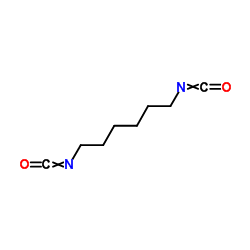六亚甲基二异氰酸酯
一般危化品

六亚甲基二异氰酸酯结构式
|
常用名 | 六亚甲基二异氰酸酯 | 英文名 | 1,6-Diisocyanatohexane |
|---|---|---|---|---|
| CAS号 | 822-06-0 | 分子量 | 168.193 | |
| 密度 | 1.0±0.1 g/cm3 | 沸点 | 255.0±0.0 °C at 760 mmHg | |
| 分子式 | C8H12N2O2 | 熔点 | -55°C | |
| MSDS | 美版 | 闪点 | 140.0±0.0 °C | |
| 符号 |



GHS05, GHS06, GHS08 |
信号词 | Danger |
|
Detection of glucose using immobilized bienzyme on cyclic bisureas-gold nanoparticle conjugate.
Anal. Biochem. 459 , 31-8, (2014) A highly sensitive electrochemical glucose sensor has been developed by the co-immobilization of glucose oxidase (GOx) and horseradish peroxidase (HRP) onto a gold electrode modified with biocompatible cyclic bisureas-gold nanoparticle conjugate (CBU-AuNP). A... |
|
|
Effect of castor oil enrichment layer produced by reaction on the properties of PLA/HDI-g-starch blends.
Carbohydr. Polym. 94(1) , 235-43, (2013) Blends of entirely bio-sourced polymers, namely polylactide (PLA) and starch, have been melt-compounded by lab-scale co-extruder with castor oil (CO) as a plasticizer. The enrichment of castor oil on starch had great effect on the properties of the blends. If... |
|
|
DNA methylation modifies urine biomarker levels in 1,6-hexamethylene diisocyanate exposed workers: a pilot study.
Toxicol. Lett. 231(2) , 217-26, (2014) DNA methylation may mediate inter-individual responses to chemical exposure and, thus, modify biomarker levels of exposure and effects. We analyzed inter-individual differences in inhalation and skin exposure to 1,6-hexamethylene diisocyanate (HDI) and urine ... |
|
|
Prick testing with chemicals in the diagnosis of occupational contact urticaria and respiratory diseases.
Contact Dermatitis 72(1) , 20-32, (2014) Little is known about the use of prick tests with chemicals in diagnosing occupational diseases.To evaluate the use of prick tests in the diagnosis of occupational contact urticaria, asthma and rhinitis caused by chemicals (undertaken at the Finnish Institute... |
|
|
Self-repairable polyurethane networks by atmospheric carbon dioxide and water.
Angew. Chem. Int. Ed. Engl. 53(45) , 12142-7, (2014) Sugar moieties were incorporated into cross-linked polyurethane (PUR) networks in an effort to achieve self-repairing in the presence of atmospheric carbon dioxide (CO2) and water (H2O). When methyl-α-D-glucopyranoside (MGP) molecules are reacted with hexamet... |
|
|
Synthesis of biodegradable polymers using biocatalysis with Yarrowia lipolytica lipase.
Methods Mol. Biol. 861 , 485-93, (2012) Yarrowia lipolytica lipase (YLL) was used as catalyst in the enzymatic ring-opening polymerization (ROP) of ε-caprolactone. This low-cost solid-state lipase produces low-molecular-weight polyesters with unique multiphase morphology as determined by carbon-13 ... |
|
|
Genetic variants in antioxidant genes are associated with diisocyanate-induced asthma.
Toxicol. Sci. 129(1) , 166-73, (2012) Diisocyanates are a common cause of occupational asthma, but risk factors are not well defined. A case-control study was conducted to investigate whether genetic variants of antioxidant defense genes, glutathione S-transferases (GSTM1, GSTT1, GSTM3, GSTP1), m... |
|
|
Occupational contact allergy to monomeric isocyanates.
Contact Dermatitis 67(2) , 78-88, (2012) The monomeric isocyanates diphenylmethane diisocyanate (MDI), 2,4-toluene diisocyanate (TDI), isophorone diisocyanate (IPDI) and 1,6-hexamethylene diisocyanate (HDI) are used in polyurethane products and sometimes cause contact allergy.To describe patients wi... |
|
|
Does diisocyanate exposure result in neurotoxicity?
Clin. Toxicol. (Phila.) 52(4) , 242-57, (2014) Diisocyanates have been associated with respiratory and dermal sensitization. Limited number of case reports, and a few case studies, media, and other references suggest potential neurotoxic effects from exposures to toluene diisocyanate (TDI), 1,6 hexamethyl... |
|
|
Receptor-based detection of 2,4-dinitrotoluene using modified three-dimensionally ordered macroporous carbon electrodes.
ACS Appl. Mater. Interfaces 4(9) , 4731-9, (2012) Detection of explosives, such as 2,4,6-trinitrotoluene (TNT), is becoming increasingly important. Here, 2,4-dinitrotoluene (DNT, a common analogue of TNT) is detected electrochemically. A receptor based electrode for the detection of DNT was prepared by modif... |